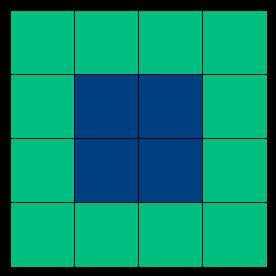|
Coefficient Ratio:
|
Homogenization Method:
|
Homogenization Tensor:
|
|
10:1
|
|
|
|
|
Arithmetic Average:
|
| 7.7500 |
0.0000 |
0.0000 |
| 0.0000 |
7.7500 |
0.0000 |
| 0.0000 |
0.0000 |
7.7500 |
|
|
|
Geometric Average:
|
| 5.6234 |
0.0000 |
0.0000 |
| 0.0000 |
5.6234 |
0.0000 |
| 0.0000 |
0.0000 |
5.6234 |
|
|
|
Harmonic Average:
|
| 3.0769 |
0.0000 |
0.0000 |
| 0.0000 |
3.0769 |
0.0000 |
| 0.0000 |
0.0000 |
3.0769 |
|
|
|
HomCode Average:
|
| 6.6514 |
0.0000 |
0.0000 |
| 0.0000 |
6.6514 |
0.0000 |
| 0.0000 |
0.0000 |
7.7500 |
|
|
|
Linear Boundary Condition Average:
|
| 6.6682 |
0.0000 |
0.0000 |
| 0.0000 |
6.6682 |
0.0000 |
| 0.0000 |
0.0000 |
7.7500 |
|
|
|
Fractured Media Tensor Average:
|
Not Applicable
|
|
|
Linear Boundary Condition Wavelet Average:
|
| 7.5050 |
0.0000 |
0.0000 |
| 0.0000 |
7.5050 |
0.0000 |
| 0.0000 |
0.0000 |
7.7500 |
|
|
|
Periodic Wavelet Average:
|
| 7.09677 |
0.0000 |
0.0000 |
| 0.0000 |
7.09677 |
0.0000 |
| 0.0000 |
0.0000 |
7.7500 |
|
|
100:1
|
|
|
|
|
Arithmetic Average:
|
| 75.2500 |
0.0000 |
0.0000 |
| 0.0000 |
75.2500 |
0.0000 |
| 0.0000 |
0.0000 |
75.2500 |
|
|
|
Geometric Average:
|
| 31.6227 |
0.0000 |
0.0000 |
| 0.0000 |
31.6227 |
0.0000 |
| 0.0000 |
0.0000 |
75.2500 |
|
|
|
Harmonic Average:
|
| 3.8835 |
0.0000 |
0.0000 |
| 0.0000 |
3.8835 |
0.0000 |
| 0.0000 |
0.0000 |
3.8835 |
|
|
|
HomCode Average:
|
| 61.0648 |
0.0000 |
0.0000 |
| 0.0000 |
61.0648 |
0.0000 |
| 0.0000 |
0.0000 |
75.2500 |
|
|
|
Linear Boundary Condition Average:
|
| 61.2806 |
0.0000 |
0.0000 |
| 0.0000 |
61.2806 |
0.0000 |
| 0.0000 |
0.0000 |
7.7500 |
|
|
|
Fractured Media Tensor Average:
|
Not Applicable
|
|
|
Periodic Wavelet Average:
|
| 67.1096 |
0.0000 |
0.0000 |
| 0.0000 |
67.1096 |
0.0000 |
| 0.0000 |
0.0000 |
75.2500 |
|
|
|
Linear Boundary Condition Wavelet Average:
|
| 72.1973 |
0.0000 |
0.0000 |
| 0.0000 |
72.1973 |
0.0000 |
| 0.0000 |
0.0000 |
75.2500 |
|
|
1000:1
|
|
|
|
|
Arithmetic Average:
|
| 750.25 |
0.0000 |
0.0000 |
| 0.0000 |
750.25 |
0.0000 |
| 0.0000 |
0.0000 |
750.25 |
|
|
|
Geometric Average:
|
| 177.83 |
0.0000 |
0.0000 |
| 0.0000 |
177.83 |
0.0000 |
| 0.0000 |
0.0000 |
750.25 |
|
|
|
Harmonic Average:
|
| 3.9880 |
0.0000 |
0.0000 |
| 0.0000 |
3.9880 |
0.0000 |
| 0.0000 |
0.0000 |
3.9880 |
|
|
|
HomCode Average:
|
| 604.818 |
0.0000 |
0.0000 |
| 0.0000 |
604.818 |
0.0000 |
| 0.0000 |
0.0000 |
750.25 |
|
|
|
Linear Boundary Condition Average:
|
| 607.029 |
0.0000 |
0.0000 |
| 0.0000 |
607.029 |
0.0000 |
| 0.0000 |
0.0000 |
7.7500 |
|
|
|
Fractured Media Tensor Average:
|
Not Applicable
|
|
|
Periodic Wavelet Average:
|
| 667.110 |
0.0000 |
0.0000 |
| 0.0000 |
667.110 |
0.0000 |
| 0.0000 |
0.0000 |
750.25 |
|
|
|
Linear Boundary Condition Wavelet Average:
|
| 719.072 |
0.0000 |
0.0000 |
| 0.0000 |
719.072 |
0.0000 |
| 0.0000 |
0.0000 |
750.25 |
|






















